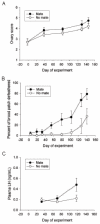A potential mate influences reproductive development in female, but not male, pine siskins
- PMID: 26836771
- PMCID: PMC4818704
- DOI: 10.1016/j.yhbeh.2016.01.006
A potential mate influences reproductive development in female, but not male, pine siskins
Abstract
The role of photoperiod in avian reproductive timing has been well studied, and we are increasingly recognizing the roles of other environmental cues such as social cues. However, few studies have evaluated the extent to which males and females of the same species respond similarly to the same type of cue. Moreover, previous studies have rarely examined how variation in the quality or nature of a given social cue might modulate its effect. Here, we examine the sensitivity of male and female pine siskins (Spinus pinus) to a potential mate as a stimulatory cue for gonadal recrudescence, and we investigate whether variation in the relationship between a bird and its potential mate modulates the effect of that potential mate. Birds were initially housed without opposite sex birds on a 12L:12D photoperiod with ad libitum food. After gonadal recrudescence had begun males and females were randomly paired with an opposite sex bird or housed alone. An additional group of males was paired with estradiol-implanted females. In males, these social treatments had no effect on testis length, cloacal protuberance length, luteinizing hormone (LH) levels, or testosterone levels. In females, presence of a potential mate had a significant and positive effect on ovary score, defeathering of the brood patch, and LH levels. Among paired birds, the degree of affiliation within a pair corresponded to the extent of reproductive development in females, but not males. Thus, reproductive timing in females appears to be sensitive to both the presence of a potential mate and her relationship with him.
Keywords: Affiliation; Birds; Breeding; Environmental cues; Luteinizing hormone; Pair formation; Reproductive timing; Sex differences; Social cues.
Copyright © 2016 Elsevier Inc. All rights reserved.
Figures




Similar articles
-
Non-photoperiodic regulation of reproductive physiology in the flexibly breeding pine siskin (Spinus pinus).Gen Comp Endocrinol. 2012 Sep 1;178(2):259-64. doi: 10.1016/j.ygcen.2012.04.023. Epub 2012 May 5. Gen Comp Endocrinol. 2012. PMID: 22569115 Free PMC article.
-
Environmental and endocrine control of reproduction in the song sparrow, Melospiza melodia. I. Temporal organization of the breeding cycle.Gen Comp Endocrinol. 1984 Dec;56(3):406-16. doi: 10.1016/0016-6480(84)90083-2. Gen Comp Endocrinol. 1984. PMID: 6510698
-
Influence of the opposite sex on photoperiodically induced LH and gonadal cycles in willow tit (Parus montanus).Horm Behav. 1995 Jun;29(2):207-15. doi: 10.1006/hbeh.1995.1015. Horm Behav. 1995. PMID: 7557923
-
Sex differences in the response to environmental cues regulating seasonal reproduction in birds.Philos Trans R Soc Lond B Biol Sci. 2008 Jan 27;363(1490):231-46. doi: 10.1098/rstb.2007.2137. Philos Trans R Soc Lond B Biol Sci. 2008. PMID: 17638693 Free PMC article. Review.
-
Females as the Gatekeepers to Seasonal Breeding: What We Can Learn by Studying Reproductive Mechanisms in Both Sexes.Integr Comp Biol. 2020 Sep 1;60(3):703-711. doi: 10.1093/icb/icaa095. Integr Comp Biol. 2020. PMID: 32617554 Review.
Cited by
-
Evolution of sexual cooperation from sexual conflict.Proc Natl Acad Sci U S A. 2019 Nov 12;116(46):23225-23231. doi: 10.1073/pnas.1904138116. Epub 2019 Oct 14. Proc Natl Acad Sci U S A. 2019. PMID: 31611370 Free PMC article.
-
Effects of a social cue on reproductive development and pre-alternate molt in seasonally breeding migrant and resident female songbirds (Zonotrichia leucophrys).J Exp Biol. 2017 Aug 15;220(Pt 16):2947-2956. doi: 10.1242/jeb.160994. J Exp Biol. 2017. PMID: 28814612 Free PMC article.
-
Estrogen levels influence medullary bone quantity and density in female house finches and pine siskins.Gen Comp Endocrinol. 2017 May 15;246:249-257. doi: 10.1016/j.ygcen.2016.12.015. Epub 2016 Dec 28. Gen Comp Endocrinol. 2017. PMID: 28039066 Free PMC article.
References
-
- Baker MC, Bjerke TK, Lampe H, Espmark Y. Sexual reponse of female great tits to variation in size of males’ song repertoires. The American Naturalist. 1986;128:491–498.
-
- Bartoń K. MuMIn: Multi-Model Inference. R package version 1.15.1. 2015 http://CRAN.R-project.org/package=MuMIn.
-
- Bates D, Maechler M, Bolker B. lme4: Linear mixed effects models using S4 classes. R package version 0.999375-42. R Foundation for Statistical Computing; Vienna, Austria: 2011. http://cran.r-project.org/package=lme4/
-
- Bentley GE, Wingfield JC, Morton ML, Ball GF. Conspecific and heterospecific male song both have stimulatory effects upon the reproductive axis in female song birds. Horm. Behav. 2000;37:179–189. - PubMed
Publication types
MeSH terms
Substances
Grants and funding
LinkOut - more resources
Full Text Sources
Other Literature Sources

